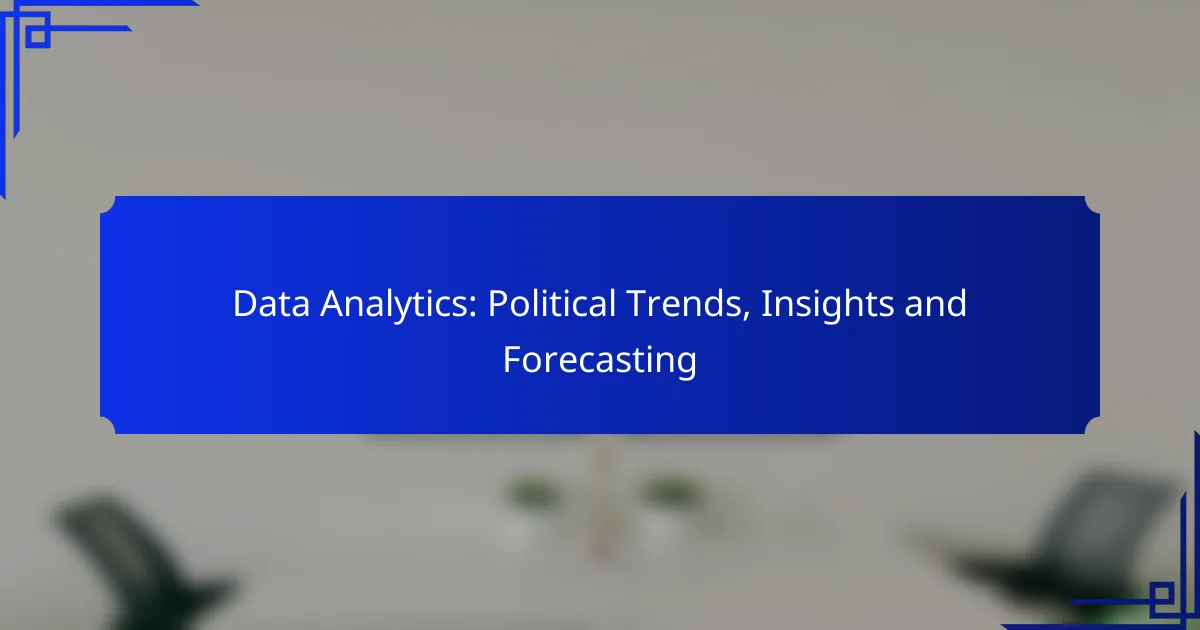Data analytics plays a crucial role in understanding political trends by examining voter behavior and preferences, which ultimately influence electoral outcomes. By leveraging historical data and advanced analytical techniques, political analysts can forecast future election results and identify patterns that shape campaign strategies. Tools such as Tableau, R, and Python enhance the ability to visualize and manipulate data, providing valuable insights into the dynamics of political landscapes.
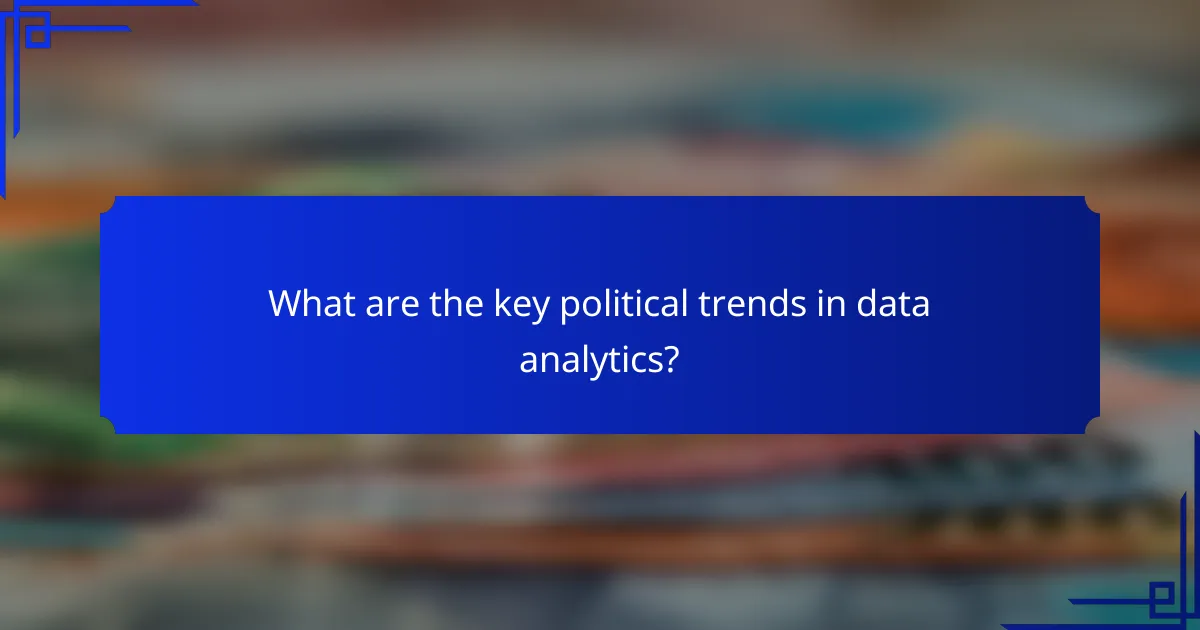
What are the key political trends in data analytics?
Key political trends in data analytics focus on understanding voter behavior, preferences, and the factors influencing electoral outcomes. By analyzing data, political analysts can identify patterns that shape campaigns and predict future voting trends.
Emerging voter demographics
Emerging voter demographics highlight shifts in the electorate, particularly among younger voters, minorities, and urban populations. These groups often have distinct preferences and priorities, which can significantly influence election results.
Political campaigns should tailor their strategies to engage these demographics effectively. For instance, utilizing platforms popular among younger voters can enhance outreach and voter mobilization efforts.
Impact of social media
Social media plays a crucial role in shaping political discourse and influencing voter opinions. Platforms like Twitter, Facebook, and Instagram allow for rapid dissemination of information and can amplify specific narratives.
Campaigns should monitor social media trends and sentiment to adapt their messaging. Engaging with voters on these platforms can foster a sense of community and encourage participation in the electoral process.
Shifts in party alignment
Shifts in party alignment reflect changing political ideologies and affiliations among voters. This trend can lead to realignments in party strength and influence, often driven by social issues, economic conditions, or major events.
Understanding these shifts is essential for parties to remain relevant. Data analytics can help identify which issues resonate with voters, guiding policy proposals and campaign strategies.
Regional voting patterns
Regional voting patterns reveal how geographic factors influence electoral outcomes. Different areas may prioritize various issues based on local economic conditions, cultural values, or historical voting behavior.
Campaigns should analyze regional data to customize their approaches, ensuring they address the specific concerns of voters in different locations. This can lead to more effective messaging and higher engagement rates.
Influence of economic factors
Economic factors significantly impact voter behavior and preferences. Issues such as unemployment rates, inflation, and economic growth can sway public opinion and voting decisions.
Political analysts should incorporate economic indicators into their data models to predict electoral outcomes accurately. Understanding the economic context can help campaigns address voter concerns and propose relevant solutions.
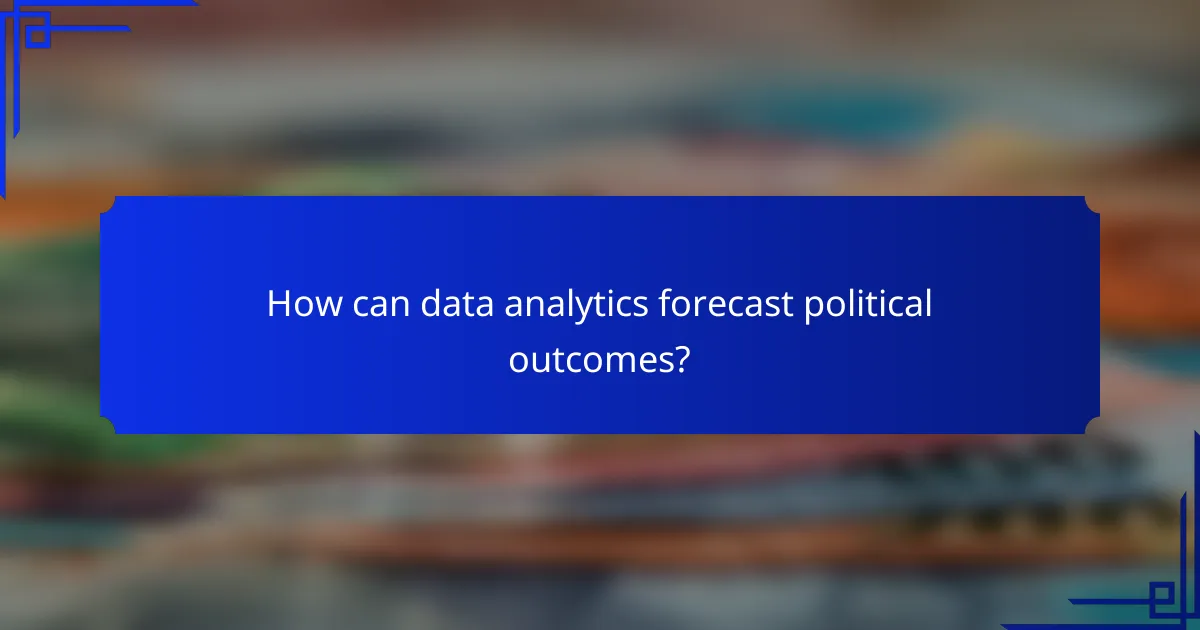
How can data analytics forecast political outcomes?
Data analytics can forecast political outcomes by analyzing historical data, trends, and voter behavior to predict future election results. This process involves various techniques that help identify patterns and insights that influence political dynamics.
Predictive modeling techniques
Predictive modeling techniques use statistical algorithms and machine learning to forecast political outcomes based on historical data. These models can incorporate various factors, such as demographic information, past voting behaviors, and economic indicators, to estimate future election results.
Common methods include regression analysis, decision trees, and ensemble methods. Each technique has its strengths; for example, regression is straightforward and interpretable, while ensemble methods can improve accuracy by combining multiple models.
Polling data analysis
Polling data analysis involves collecting and interpreting survey data to gauge public opinion on political issues and candidates. This analysis can reveal trends in voter preferences and help campaigns adjust their strategies accordingly.
Key considerations include sample size, margin of error, and question wording, as these factors can significantly impact results. Polls should be conducted regularly to track changes over time, especially as elections approach.
Machine learning applications
Machine learning applications in political forecasting utilize algorithms to analyze vast datasets, identifying complex patterns that traditional methods might miss. These applications can process real-time data from social media, news articles, and other sources to provide up-to-date insights.
Examples include sentiment analysis, which assesses public mood towards candidates, and clustering techniques that segment voters based on shared characteristics. However, it is crucial to ensure data quality and relevance to avoid misleading predictions.
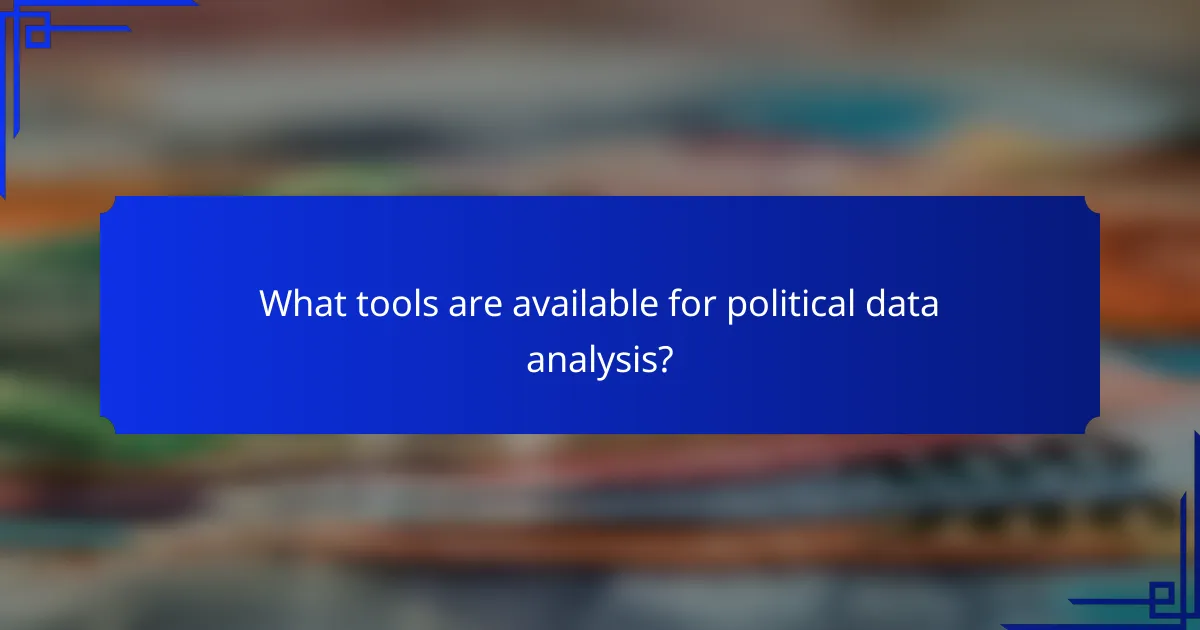
What tools are available for political data analysis?
Political data analysis can be effectively conducted using various tools that cater to different aspects of data handling, including visualization, statistical analysis, and data manipulation. Key tools include Tableau, R, and Python, each offering unique strengths for analyzing political trends and insights.
Tableau for visualization
Tableau is a powerful data visualization tool that enables users to create interactive and shareable dashboards. It allows political analysts to visually represent complex datasets, making it easier to identify trends and patterns in voter behavior or election results.
To get started with Tableau, users should focus on connecting their data sources, such as CSV files or databases, and then use drag-and-drop features to create visualizations. Common pitfalls include overcomplicating dashboards or failing to ensure data accuracy, which can mislead interpretations.
R for statistical analysis
R is a programming language specifically designed for statistical computing and graphics, making it ideal for in-depth political data analysis. Analysts can use R to perform complex statistical tests, create predictive models, and visualize data through various packages like ggplot2.
When using R, it’s essential to understand the basics of data manipulation and statistical concepts. Analysts should avoid common mistakes such as misinterpreting p-values or neglecting to check assumptions of statistical tests, which can lead to erroneous conclusions.
Python for data manipulation
Python is a versatile programming language widely used for data manipulation and analysis, particularly in political data contexts. Libraries such as Pandas and NumPy allow analysts to clean, transform, and analyze large datasets efficiently.
To effectively use Python for political data analysis, focus on mastering data cleaning techniques and understanding how to work with different data formats. Analysts should be cautious of data integrity issues and ensure they validate their datasets before drawing conclusions or making forecasts.
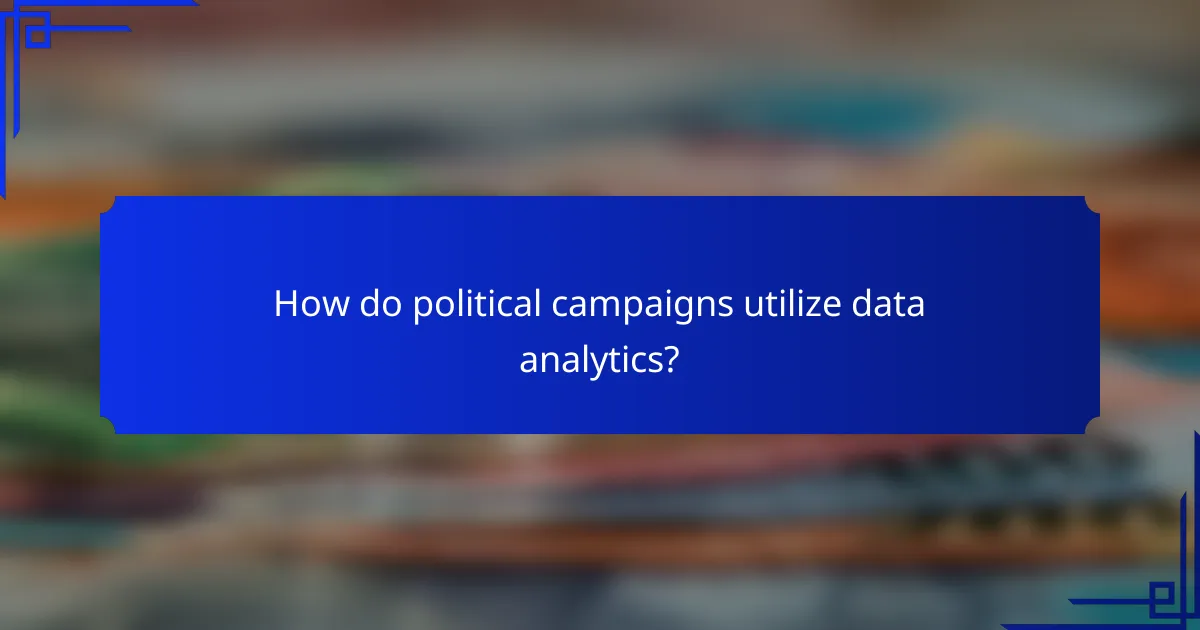
How do political campaigns utilize data analytics?
Political campaigns leverage data analytics to enhance decision-making, optimize resource allocation, and improve voter engagement. By analyzing voter data, campaigns can identify trends, preferences, and behaviors that inform their strategies.
Targeted advertising strategies
Targeted advertising strategies involve using data analytics to segment voters based on demographics, interests, and behaviors. This allows campaigns to deliver tailored messages to specific groups, increasing the likelihood of engagement and conversion.
For instance, campaigns may focus on younger voters through social media platforms while targeting older demographics with traditional media. By analyzing engagement metrics, campaigns can adjust their spending to maximize impact across various channels.
Voter outreach optimization
Data analytics helps optimize voter outreach by identifying the most effective communication channels and timing for different voter segments. Campaigns can analyze past election data to determine when voters are most receptive to outreach efforts.
Using predictive modeling, campaigns can prioritize outreach to undecided voters or those with a history of low turnout. This targeted approach ensures resources are spent efficiently, enhancing overall voter mobilization efforts.
Message tailoring based on data
Message tailoring based on data involves crafting campaign messages that resonate with specific voter segments. By analyzing voter sentiment and preferences, campaigns can create content that addresses the concerns and interests of their target audience.
For example, a campaign might emphasize economic issues for voters in a struggling region while highlighting healthcare for those in areas with high medical costs. This level of personalization can significantly enhance voter connection and support.
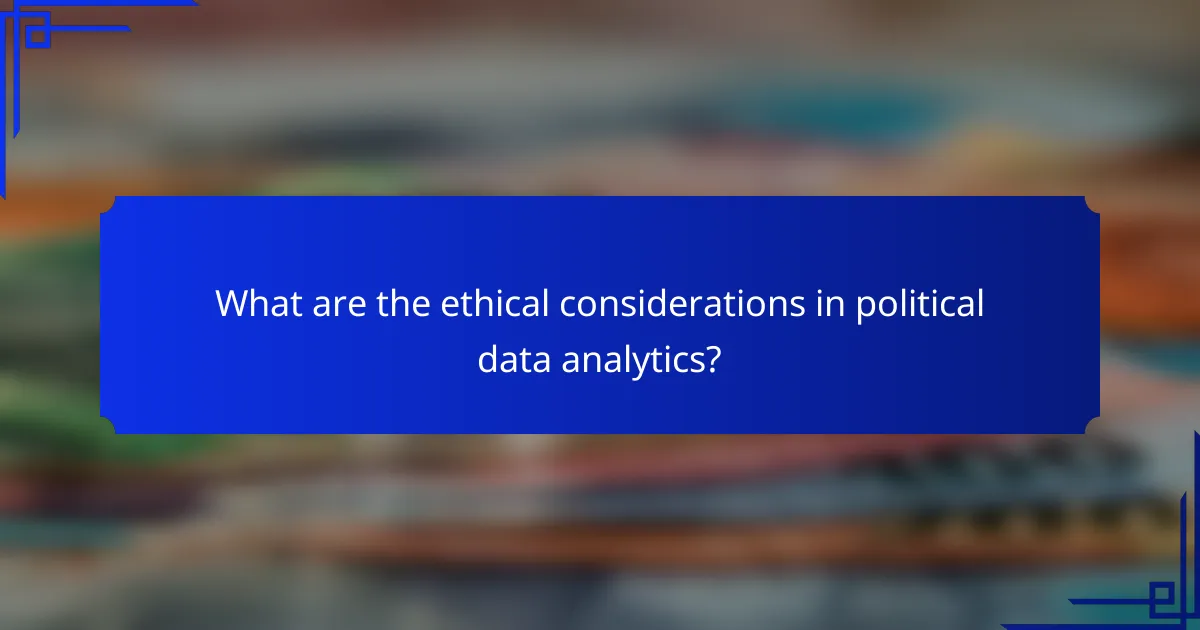
What are the ethical considerations in political data analytics?
Ethical considerations in political data analytics revolve around the responsible use of data to ensure fairness, transparency, and respect for individuals’ rights. Key issues include data privacy, bias in interpretation, and the potential for manipulation of public opinion.
Data privacy concerns
Data privacy is a critical issue in political data analytics, as it involves the collection and use of personal information from voters. Organizations must comply with regulations like the General Data Protection Regulation (GDPR) in Europe, which mandates transparency and consent for data collection.
To address privacy concerns, political analysts should implement strong data protection measures, such as anonymizing datasets and limiting access to sensitive information. Regular audits and compliance checks can help ensure adherence to privacy standards.
Bias in data interpretation
Bias in data interpretation can significantly affect political analytics, leading to skewed insights and potentially misleading conclusions. Analysts must be aware of their own biases and the limitations of the data sources they use, as these factors can influence the outcomes of their analyses.
To mitigate bias, it is essential to use diverse data sources and apply rigorous methodologies. Engaging with a range of stakeholders can also provide different perspectives, helping to create a more balanced understanding of political trends.
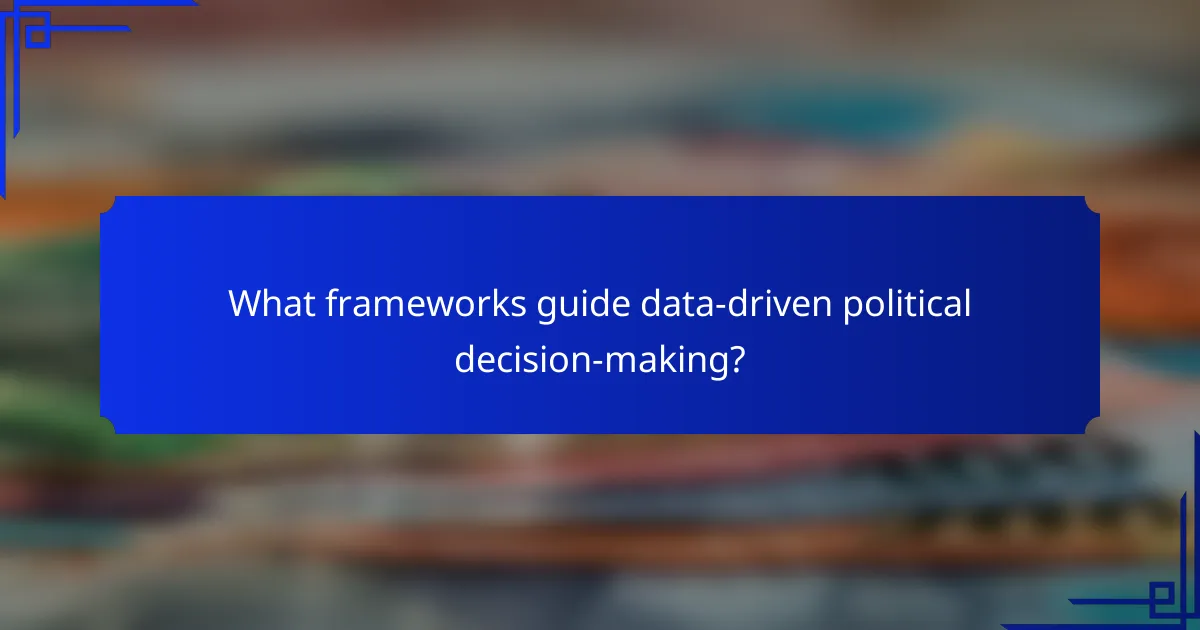
What frameworks guide data-driven political decision-making?
Data-driven political decision-making is guided by various frameworks that help analyze trends, assess risks, and optimize strategies. These frameworks enable political entities to leverage data effectively, ensuring informed choices that resonate with constituents and stakeholders.
SWOT analysis for campaigns
SWOT analysis is a strategic planning tool that evaluates the Strengths, Weaknesses, Opportunities, and Threats of a political campaign. By identifying internal strengths and weaknesses alongside external opportunities and threats, campaigns can develop targeted strategies that enhance their chances of success.
For example, a campaign might identify strong grassroots support as a strength, while a lack of funding could be a weakness. Opportunities may include favorable public sentiment on key issues, whereas threats could involve strong opposition from well-funded rivals. Regularly updating the SWOT analysis helps campaigns adapt to changing political landscapes.
Data governance policies
Data governance policies are essential for ensuring that political campaigns manage data responsibly and ethically. These policies outline how data is collected, stored, processed, and shared, aiming to protect voter privacy and comply with regulations such as GDPR or CCPA.
Effective data governance involves establishing clear protocols for data access and usage, training staff on data protection, and implementing security measures to prevent breaches. Campaigns should regularly review their data governance policies to align with evolving legal standards and public expectations, fostering trust among constituents.
